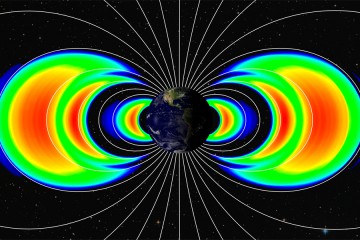Scientists have discovered a new, persistent pattern in Earth's inner radiation belt using data from the twin NASA Van Allen Probes spacecraft.

Image caption: An example of energetic electron spectra, measured on June 18, 2013, by NASA's twin Van Allen Probes in the inner radiation belt during low solar activity. The striped, banded pattern is caused by the rotation of the Earth, previously thought to have no effect on the highly energetic particles of the radiation belt.
Image credit: Aleksandr Ukhorskiy, APL
Most surprisingly, the pattern is produced by the slow rotation of Earth, which was previously considered incapable of affecting the motion of radiation belt particles, which have velocities that approach the speed of light.
Data from the Van Allen Probes Ion Composition Experiment (RBSPICE) on board each of the twin spacecraft orbiting Earth revealed that the highly energized population of electrons of the inner radiation belt is organized into very structured arrays that resemble slanted zebra stripes.
Scientists had previously believed that increased solar wind activity was the primary force behind any patterns in our planet's radiation belts. But these zebra stripes were shown to be visible even during low solar wind activity, which prompted a search for an alternate explanation of how they form, leading to the unexpected discovery. The findings are reported in the March 20 issue of the journal Nature.
"It is because of the unprecedented high energy and temporal resolution of our energetic particle experiment, RBSPICE, that we now understand that the inner belt electrons are, in fact, always organized in zebra patterns," said Aleksandr Ukhorskiy of the Johns Hopkins Applied Physics Laboratory, co-investigator on RBSPICE and lead author of the paper. "Furthermore, our modeling clearly identifies Earth's rotation as the mechanism creating these patterns. It is truly humbling, as a theoretician, to see how quickly new data can change our understanding of physical properties."
Because of the tilt in Earth's magnetic field axis, the planet's rotation generates an oscillating, weak electric field that permeates through the entire inner radiation belt. To understand how that field affects the electrons, Ukhorskiy suggested an analogy: "If the inner belt electron populations are viewed as a viscous fluid, these global oscillations slowly stretch and fold that fluid, much like taffy is stretched and folded in a candy store machine," he said.
This stretching and folding process results in the striped pattern observed across the entire inner electron belt, extending from above Earth's atmosphere (about 500 miles above the planet's surface) up to roughly 8,000 miles.
The radiation belts are dynamic, doughnut-shaped regions around our planet, extending high above the atmosphere, made up of high-energy particles trapped by Earth's magnetic field. Radiation levels across the belts are affected by solar activity, such as solar storms, and can ebb and flow. During active conditions, radiation levels can dramatically increase, which can create hazardous space weather conditions that harm orbiting spacecraft and endanger humans in space. The goal of the Van Allen Probes mission is to shed light on how and why radiation levels in the belts change with time.
"This is another fundamental understanding made possible thanks to the highly detailed data being returned from these remarkable spacecraft," said Louis Lanzerotti, distinguished research professor of physics at the Center for Solar-Terrestrial Research at the New Jersey Institute of Technology, principal investigator for RBSPICE, and a co-author on the paper. "It is amazing how Earth's space environment, including the radiation belts, continue to surprise us even after we have studied it for over 50 years. Our understanding of the complex structures of the belts, and the processes behind the belts' behaviors, continues to grow, all of which contributes to the eventual goal of providing accurate space weather modeling."
NASA launched the twin Van Allen probes in the summer of 2012. APL built and operates the probes for NASA's Science Mission Directorate. The Van Allen Probes are the second mission in NASA's Living with a Star program, managed by NASA's Goddard Space Flight Center. The program explores aspects of the connected sun-Earth system that directly affect life and society.
"This finding tells us something new and important about how the universe operates," said Barry Mauk of APL, Van Allen Probes project scientist and an author of the paper. "The new results reveal a new large-scale physical mechanism that can be important for planetary radiation belts throughout the solar system. An instrument similar to RBSPICE is now on its way to Jupiter on NASA's Juno mission, and we will be looking for the existence of zebra stripe-like patterns in Jupiter's radiation belts."
Posted in Science+Technology
Tagged applied physics laboratory, nasa, space









